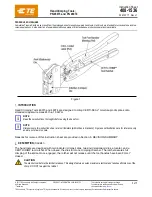
41
General Sharpening Procedures
Turning to blade shape, the general rule of thumb
for standard bench planes (#3 to #8) is that the blade
be sharpened square across unless you intend to be
working wood wider than the blade; in this case, you
would either round the blade corners, crown the blade
or do a bit of both, depending on your intended use.
Smoothing Planes
(#3, #4½, #5½)
The #3 smoothing plane is usually used for the fi nal
smoothing of large fl at surfaces. It is not used to take
off much material, so it should be set for a very fi ne
shaving. You want the corners of the blade to be slightly
rounded, so that overlapping passes of slightly different
height will not have a distinct overlap line nor will you
get any fi ber tearing as would be the case with a square-
edge blade.
Whether or not you use a honing guide, it is a fairly
simple matter to put a straight basic bevel on a
smoothing-plane blade and then bias the process fi rst
to one corner and then to the other to round off the last
1
/
8
in. or
1
/
4
in. of blade. The rounding does not have to
be substantial, since the plane will be used only for very
light fi nishing cuts.
The #4
1
/
2
and #5
1
/
2
are planes designed for hogging
off wood in the smoothing process. In normal use it is
not enough to just round the corners of these blades,
the entire blade should be crowned by
1
/
32
in. to
1
/
16
in.
This can be done with a honing guide putting "English"
on one side and then the other, but it can be diffi cult
to get enough curvature this way. One easy solution is
to keep a worn stone specifi cally for sharpening such
blades. Such an out-of-true stone can be used only for
the bevels and never for lapping. A better alternative is
to use a simple jig to grind the crown, as shown in the
sidebar on the next page.
Scrub Plane
The scrub plane is the very roughest of the smoothing
planes and is used for major stock removal. The blade
comes with quite a sharply curved edge, which is fairly
easy to maintain using exactly the same principle
described in the sidebar on the facing page (only in this
instance a slightly modifi ed jig would be necessary to
hold the blade farther up). The grind radius can be as
little as 1
1
/
2
in.
Jack Planes, Jointer Planes
and Others (#5, #6, #7 and #8)
Most woodworkers use these larger planes (jack, fore,
jointer, trying and panel planes) only for working the
edge of stock, in which case the blade can be ground
and honed perfectly square. For use on surfaces wider
than the plane, you would ease the corners of the blade
as described under smoothing planes.
Block Planes
Whereas bench planes are generally used with the grain,
the block plane was designed to work end grain. Today
it is used for all types of cuts, but its name comes from
its original use in dressing the top of butchers’ blocks.
As the various ways to shape the blade are discussed
below, keep in mind that the recommendations are
aimed at effective end-grain cutting.
Block planes provide an opportunity for some very
innovative sharpening, but they are probably among the
worst-made planes on the market today. For example, of
the four block planes made by Record and Stanley, only
the Record #09
1
/
2
has a lever cap that is long enough. Since
block planes do not have cap irons, the lever cap has to
do double duty whenever a cap iron would be desirable
If you have a short lever cap on your block plane, it will apply
pressure behind the machined portion of the bed caus ing
the end of the blade to be lifted away from the bed. To reduce
blade chatter caused by this flaw, you have to lower the bed
angle so that the blade rests on the bed at the mouth, not
1
/
4
in. back of the mouth. To dress the bed, strip the plane
(removing the adjustable nosepiece) and file the bed, letting
the file pass through the open mouth and using the frog post
as a guide since it is several degrees below the blade line on
all modern block planes. (The low post is another flaw, but at
least it works in your favor for this process.)
If you find it too difficult to get even seating of the tensioned
blade along the entire bed, you can relieve just the back
part of the bed so that the blade only touches at the mouth.
That is still better than the condition you are correcting.
Lowering the Bed Angle on a Block Plane
Lever cap
Remove material
here to lower bed
angle.
Gap caused by short lever cap
Frog post
Blade
Summary of Contents for Mk.II
Page 6: ...vi Veritas Mk II Power Sharpening System ...
Page 14: ...8 Veritas Mk II Power Sharpening System ...
Page 20: ...14 Veritas Mk II Power Sharpening System ...
Page 33: ...27 Exploded Assemblies Master Parts List 5 3 13 9 7 2 14 24 21 1 6 22 20 19 18 17 16 15 23 4 ...
















































